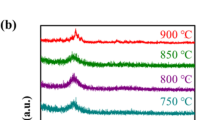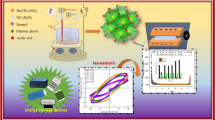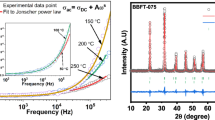Abstract
In this study, Nb-doped (0.00 ≤ x ≤ 0.025) lead-free 0.5BZT–0.5BCT films were prepared on Pt/Ti/SiO2/(100)Si substrates by the sol–gel method. The effects of Nb content on the structure, diffusion phase transformation, dielectric and ferroelectric properties of the films were investigated. XRD and Raman spectra indicated the coexistence of T and R phases at room temperature in all the films, and the tetragonality of the films decreased with increasing Nb content. The ferroelectric–paraelectric phase transition temperature decreased, and the diffuseness phase transition gradually increased with increasing Nb content. Low Nb doping caused significant improvement in dielectric and ferroelectric properties at room temperature. Excellent dielectric properties with a large dielectric constant (εr = 3556) and high remanent polarization (Pr of 7.2 μC/cm2) were obtained for the films with x = 0.002. A large improvement in dielectric properties indicates that these films might be a potential material for dielectric applications.







Similar content being viewed by others
Data and code availability
All data which are analyzed and used to support this study are included in the submitted article.
References
Haertling GH (1999) Ferroelectric ceramics: History and technology. J Am Ceram Soc 82:797–818
Zhang CH, Chi QG, He XX et al (2016) Microstructure and electric properties of Nb doping x(Ba0.7Ca0.3)TiO3–(1–x)Ba(Zr0.2Ti0.8)O3 ceramics. J Alloys Compd 685:936–940
Dong HT, Chen MJ, Zhu HJ et al (2020) Effects of thermal strain on electric properties of lead zirconate titanate thin films upon LaNiO3 coated base metal plates. Ceram Int 46:1883–1887
Swain S, Bhaskar R, Mishra B et al (2022) Microstructural, dielectric, mechanical, and biological properties of hydroxyapatite (HAp)/BZT–BCT (0.5Ba(Zr0.2Ti0.8)O3–0.5(Ba0.7Ca0.3)TiO3) bio-composites with improved mechano-electrical properties for bone repair. Ceram Int 48:24505–24516
Swain S, Kumar P (2021) Sonia, Microstructural, mechanical and electrical properties of BT, BZT–BCT, and BNT–BT–BKT ferroelectrics synthesized by mechanochemical route. Ceram Int 47:26511–26518
Barbatoa PS, Casuscellib V, Aprea P et al (2021) Optimization of the production process of BZT–BCT sol–gel thin films obtained from a highly stable and green precursor solution. Mater Manuf Processes 36:1642–1649
Liu W, Ren XB (2009) Large piezoelectric effect in Pb-free ceramics. Phys Rev Lett 103:257602
Kang GQ, Yao K, Wang J (2012) (1–x)Ba(Zr0.2Ti0.8)O3–x(Ba0.7Ca0.3)TiO3 ferroelectric thin films prepared from chemical solutions. J Am Ceram Soc 95:986–991
Dey K, Ahad A, Gautam K et al (2021) Coexistence of local structural heterogeneities and long-range ferroelectricity in Pb-free (1–x)Ba(Zr0.2Ti0.8)O3–x(Ba0.7Ca0.3)TiO3 ceramics. Phys Rev B Condens Matter 103:L100205
Syal R, Goel R, De A et al (2021) Flattening of free energy profile and enhancement of energy storage efficiency near morphotropic phase boundary in lead-free BZT–xBCT. J Alloys Compd 873:159824
Yan XD, Zheng MP, Gao X et al (2020) High-performance lead-free ferroelectric BZT–BCT and its application in energy fields. J Mater Chem C 8:13530–13556
Qiao J, Zheng C, Zhang Y et al (2017) Enhanced resistive memory in Nb-doped BaTiO3 ferroelectric diodes. Appl Phys Lett 111:032902
Shen ZB, Wang XH, Song DS et al (2016) Nb-doped BaTiO3–(Bi0.5Na0.5)TiO3 ceramics with core-shell structure for high-temperature dielectric applications. Adv Appl Ceram 115:1–8
Chu SY, Chen TY, Tsai IT et al (2004) Doping effects of Nb additives on the piezolectric and dielectric properties of PZT ceramics and its application on SAW device. Sens Actuators A 113:198–203
Volkan K, Macit O (2009) The effect of Nb doping on dielectric and ferroelectric properties of PZT thin films prepared by solution deposition. J Eur Ceram Soc 29:1157–1163
Kumar K, Kumar B (2012) Effect of Nb-doping on dielectric, ferroelectric and conduction behaviour of lead free Bi0.5(Na0.5K0.5)0.5TiO3 ceramic. Ceram Int 38:1157–1165
Parjansri P, Intatha U, Eitssayeam S (2015) Dielectric, ferroelectric and piezoelectric properties of Nb5+ doped BCZT ceramics. Mater Res Bull 65:61–67
Zhang C, Liu QB, Huang XQ (2013) Effect of sintering temperature on microstructure and electrical properties of (Mn, Nb)-doped BZT–BCT ceramics. Adv Mater Res 820:59–62
J Cardoletti, P Komissinskiy, S Drnovsek, et al. (2021) 001-Textured Nb-Doped Pb(Zr,Ti)O3 thin films on Stainless Steel by Pulsed Laser Deposition, ISAF. IEEE, 1–4.
Jaiban P, Theethuan T, Khumtrong S et al (2022) The effects of donor (Nb5+) and acceptor (Cu2+, Zn2+, Mn2+, Mg2+) doping at B-site on crystal structure, microstructure, and electrical properties of (Ba0.85Ca0.15)Zr0.1Ti0.9O3 ceramics. J Alloys Compd 899:162909
Praveen JP, Kumar K, James AR et al (2014) Large piezoelectric strain observed in sol-gel derived BZT–BCT ceramics. Curr Appl Phys 14:396–402
Li BZ, Blendell JE, Bowman KJ (2011) Temperature-dependent poling behavior of lead-free BZT–BCT piezoelectrics. J Am Ceram Soc 94:3192–3194
Abdmouleh H, Kriaa I, Abdelmoula N et al (2021) The effect of Zn2+ and Nb5+ substitution on structural, dielectric, electrocaloric properties, and energy storage density of Ba0.95Ca0.05Ti0.95Zr0.05O3 ceramics. J Alloys Compd 878:160355
Huang XC, Liu HX, Song Z et al (2015) Structure–property relationships in BaTiO3–(Na1/4Bi3/4)(Mg1/4Ti3/4)O3 lead-free ceramics. J Eur Ceram Soc 36:533–540
Venkateswaran UD, Naik VM, Naik R (1998) High-pressure Raman studies of polycrystalline BaTiO3. Phys Rev B 58:14256–14260
Coondoo I, Panwar N, Amorın H et al (2015) Enhanced piezoelectric properties of praseodymium-modified Lead-Free (Ba0.85Ca0.15)(Ti0.90Zr0.10)O3 ceramics. J Am Ceram Soc 98:3127–3135
Huang L, Dai Y, Wu Y et al (2016) Enhanced ferroelectric and piezoelectric properties of (1–x)BaZr0.2Ti0.8O3–xBa0.7Ca0.3TiO3 thin films by sol–gel process. Appl Surf Sci 388:35–39
Ramajo L, Camargo J, Rubio-Marcos F et al (2015) Influences of secondary phases on ferroelectric properties of Bi(Na, K)TiO3 ceramics. Ceram Int 41:5380–5386
Shakeri A, Abdizadeh H, Golobostanfard MR (2016) Fabrication of Nb-doped lead zirconate titanate thick films synthesized by sol–gel dip coating method. J Mater Sci: Mater Electron 27:5654–5664
Sabrina BP, Valeria C, Paolo A et al (2021) Optimization of the production process of BZT–BCT sol–gel thin films obtained from a highly stable and green precursor solution. Mater Manuf Processes 36(14):1642–1649
Ion V, Craciun F, Scarisoreanu ND et al (2018) Impact of thickness variation on structural, dielectric and piezoelectric properties of (Ba, Ca)(Ti, Zr)O3 epitaxial thin films. Sci Rep 8:2056
Dai Q, Wu D, Guo K et al (2018) Ferroelectric, dielectric, ferromagnetic and magnetoelectric properties of the multiferroic heteroepitaxial NiFe2O4/Ba0.85Ca0.15Ti0.9Zr0.1O3 composite thin films deposited via PLD. J Mater Sci Mater Electron 29:17333–17340
Liu XK, Dai Y, Pei XM et al (2023) Giant room-temperature electrocaloric effect within wide temperature span in Sn-doped Ba0.85Ca0.15Zr0.1Ti0.9O3 lead-free thin films. Ceram Int 49:1846–1854
Lu HW, Liu LZ, Lin JQ et al (2018) Effects of Tb doping on structural and electrical properties of 0.47(Ba0.7Ca0.3)TiO3–0.53Ba(Zr0.2Ti0.8)O3 thin films at various annealing temperature by pulsed laser deposition. Ceram Int 44:6514–6519
Chan H, Harmer MP, Smyth D (1986) Compensating defects in highly donor-doped BaTiO3. J Am Ceram Soc 69:507–510
Hayashi T (1997) Preparation and properties of niobium oxide coated barium titanate composite powders. Met Powder Rep 52:40
Li W, Hao JG, Zeng HR et al (2013) Dielectric and piezoelectric properties of the Ba0.92Ca0.08Ti0.95Zr0.05O3 thin films grown on different substrate. Curr Appl Phys 13:1205–1208
Wang W, Wang LD, Li WL et al (2015) Effect of pore content on diffuse phase transition behaviour of porous 0.5BaZr0.2Ti0.8O3–0.5Ba0.7Ca0.3TiO3 ceramics. J Alloys Compd 624:284–289
Uchino K, Nomura S (1982) Ferroelectrics critical exponents of the dielectric constants in diffused-phase-transition crystals. Ferroelectr 44:55–61
Lin YT, Qin N, Wu GH et al (2012) Dielectric relaxor behaviors and tunability of (1–x)Ba(Zr0.2Ti0.8)O3–x(Ba0.7Ca0.3)TiO3 thin films fabricated by sol–gel method. Appl Phys A 109:743–749
Coondoo I, Panwar N, Amorın H et al (2013) Synthesis and characterization of lead-free 0.5Ba(Zr0.2Ti0.8)O3–0.5(Ba0.7Ca0.3)TiO3 ceramic. J Appl Phys 113:214107
Coondoo I, Agarwal SK, Jha AK (2009) Ferroelectric and piezoelectric properties of tungsten substituted SrBi2Ta2O9 ferroelectric ceramics. Mater Res Bull 44:1288–1292
Pontes FM, Pontes DSL, Leite ER et al (2002) Influence of Ca concentration on the electric, morphological, and structural properties of (Pb, Ca)TiO3 thin films. J Appl Phys 91:6650–6655
Li W, Xu ZJ, Chu RQ et al (2012) Structural and dielectric properties in the (Ba1-xCax)(Ti0.95Zr0.05)O3 ceramics. Curr Appl Phys 12:748–751
Hao H, Liu HX, Min XM et al (2015) Theoretical analysis on the structure of Nb-doped SrBi4Ti4O15. Int J Quantum Chem 111:669–674
Castro E (2004) Influence of Nb5+ and Sb3+ dopants on the defect profile, PTCR effect and GBBL characteristics of BaTiO3 ceramics. J Eur Ceram Soc 24:2499–2507
Huang T, Hu ZG, Xu GS et al (2014) Inherent optical behavior and structural variation in Na0.5Bi0.5TiO3–6%BaTiO3 revealed by temperature dependent Raman scattering and ultraviolet-visible transmittance. Appl Phys Lett 104:111098
Acknowledgements
This work was supported by National Natural Science Foundation of China (No. 51772225), Natural Science Foundation of Shaanxi Provincial (No. 2019JQ-922), Natural Science Foundation of Shaanxi Provincia Department of Eudcation (No. 19JK0908), and Weinan Normal University Doctoral Research Launch Fund (No. 2020RC06).
Author information
Authors and Affiliations
Contributions
All authors contributed to the study conception and design. Material preparation, data collection, analysis, and the first draft of the manuscript were mainly performed by LH and assisted by ML and XL. Funding acquisition, resources, and supervision were performed by YD and LH. The final manuscript was approved by YD; all authors commented on previous versions of the manuscript. All authors read and approved the final manuscript.
Corresponding author
Ethics declarations
Conflict of interest
We have no relevant financial or non-financial interests to disclose.
Additional information
Handling Editor: David Cann.
Publisher's Note
Springer Nature remains neutral with regard to jurisdictional claims in published maps and institutional affiliations.
Rights and permissions
Springer Nature or its licensor (e.g. a society or other partner) holds exclusive rights to this article under a publishing agreement with the author(s) or other rightsholder(s); author self-archiving of the accepted manuscript version of this article is solely governed by the terms of such publishing agreement and applicable law.
About this article
Cite this article
Huang, L., Dai, Y., Li, M. et al. Effect of Nb doping on the microstructure and electrical properties of 0.5BZT–0.5BCT thin films prepared by the sol–gel method. J Mater Sci 58, 13925–13934 (2023). https://doi.org/10.1007/s10853-023-08553-w
Received:
Accepted:
Published:
Issue Date:
DOI: https://doi.org/10.1007/s10853-023-08553-w




